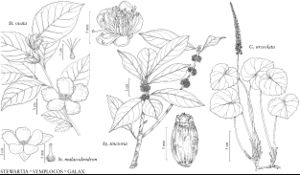Difference between revisions of "Diapensiaceae"
FNA>Volume Importer |
FNA>Volume Importer |
||
| Line 18: | Line 18: | ||
|distribution=North America;Europe;Asia. | |distribution=North America;Europe;Asia. | ||
|discussion=<p>Genera 5, species 14 (4 genera, 6 species in the flora).</p><!-- | |discussion=<p>Genera 5, species 14 (4 genera, 6 species in the flora).</p><!-- | ||
| − | --><p>In addition to the four genera treated here, one other genus completes the family: Berneuxia Decaisne, with one species in the Sino-Himalayan Mountains. Diapensia lapponica and its sister D. obovata, as a pair, are circumboreal in distribution; all of the other species of the family are narrowly distributed. A phylogenetic analysis based on morphology and molecular data from four genes (K. Rönblom and A. A. Anderberg 2002) indicated that Galax is sister to all other genera; Pyxidanthera is sister to the remaining genera at the next higher node; relationships among Berneuxia, Diapensia, and Shortia are unresolved. In this interpretation, the “inverted-eucamptodromous” venation pattern shared by Diapensia and Pyxidanthera (H. T. Murphy and J. W. Hardin 1976) was perhaps developed in parallel.</p><!-- | + | --><p>In addition to the four genera treated here, one other genus completes the family: Berneuxia Decaisne, with one species in the Sino-Himalayan Mountains. <i>Diapensia lapponica</i> and its sister <i>D. obovata</i>, as a pair, are circumboreal in distribution; all of the other species of the family are narrowly distributed. A phylogenetic analysis based on morphology and molecular data from four genes (K. Rönblom and A. A. Anderberg 2002) indicated that <i>Galax</i> is sister to all other genera; <i>Pyxidanthera</i> is sister to the remaining genera at the next higher node; relationships among Berneuxia, <i>Diapensia</i>, and <i>Shortia</i> are unresolved. In this interpretation, the “inverted-eucamptodromous” venation pattern shared by <i>Diapensia</i> and <i>Pyxidanthera</i> (H. T. Murphy and J. W. Hardin 1976) was perhaps developed in parallel.</p><!-- |
| − | --><p>Leaves of Diapensia, Galax, and some Shortia species become reddish to purplish or orange-bronze (anthocyanic) in the fall and winter. The colored leaves of Galax are gathered in the fall for the florist trade. Leaves of all genera of Diapensiaceae sequester large amounts of aluminum (L. Schultz, pers. comm.), an unusual characteristic for temperate plants.</p> | + | --><p>Leaves of <i>Diapensia</i>, <i>Galax</i>, and some <i>Shortia</i> species become reddish to purplish or orange-bronze (anthocyanic) in the fall and winter. The colored leaves of <i>Galax</i> are gathered in the fall for the florist trade. Leaves of all genera of Diapensiaceae sequester large amounts of aluminum (L. Schultz, pers. comm.), an unusual characteristic for temperate plants.</p> |
|tables= | |tables= | ||
|references={{Treatment/Reference | |references={{Treatment/Reference | ||
| Line 92: | Line 92: | ||
|publication year= | |publication year= | ||
|special status= | |special status= | ||
| − | |source xml=https://jpend@bitbucket.org/aafc-mbb/fna-data-curation.git/src/ | + | |source xml=https://jpend@bitbucket.org/aafc-mbb/fna-data-curation.git/src/8f726806613d60c220dc4493de13607dd3150896/coarse_grained_fna_xml/V8/V8_656.xml |
}}<!-- | }}<!-- | ||
-->[[Category:Treatment]] | -->[[Category:Treatment]] | ||
Revision as of 18:08, 18 September 2019
Perennial herbs or subshrubs, evergreen, rhizomatous and/or stems creeping and adventitiously rooted, sometimes taprooted, ecto- and endotrophically mycorrhizal. Stems erect to decumbent or prostrate. Leaves basal and cauline, alternate or opposite, simple; stipules absent; petiole present or absent; blade margins entire or dentate-serrate. Inflorescences terminal racemes or solitary flowers. Flowers bisexual; perianth and androecium hypogynous; sepals 5, connate proximally or distinct; petals 5, connate proximally or distinct; stamens 5, antisepalous or basally connate into ring, epipetalous, alternating with staminodes; anthers transversely or longitudinally dehiscent; staminodes absent or 5, scalelike or spatulate; pistils 1, 3-carpellate; ovary superior, 3-locular; placentation axile; ovules usually anatropous, sometimes axile, hemitropous, campylotropous, or amphitropous, bitegmic, tenuinucellate; styles 1, terminal; stigmas 1, slightly 3-lobed to unlobed and capitate [disciform]. Fruits capsular, dehiscence loculicidal. Seeds 10–30, brown, cylindric; embryo straight to curved; endosperm copious, fleshy.
Distribution
North America, Europe, Asia.
Discussion
Genera 5, species 14 (4 genera, 6 species in the flora).
In addition to the four genera treated here, one other genus completes the family: Berneuxia Decaisne, with one species in the Sino-Himalayan Mountains. Diapensia lapponica and its sister D. obovata, as a pair, are circumboreal in distribution; all of the other species of the family are narrowly distributed. A phylogenetic analysis based on morphology and molecular data from four genes (K. Rönblom and A. A. Anderberg 2002) indicated that Galax is sister to all other genera; Pyxidanthera is sister to the remaining genera at the next higher node; relationships among Berneuxia, Diapensia, and Shortia are unresolved. In this interpretation, the “inverted-eucamptodromous” venation pattern shared by Diapensia and Pyxidanthera (H. T. Murphy and J. W. Hardin 1976) was perhaps developed in parallel.
Leaves of Diapensia, Galax, and some Shortia species become reddish to purplish or orange-bronze (anthocyanic) in the fall and winter. The colored leaves of Galax are gathered in the fall for the florist trade. Leaves of all genera of Diapensiaceae sequester large amounts of aluminum (L. Schultz, pers. comm.), an unusual characteristic for temperate plants.
Selected References
Lower Taxa
Illustrations
Key
| 1 | Leaf blades subpalmately veined; inflorescences compact racemes; corollas 3.5-8 mm; anthers 1-locular, transversely dehiscent. | Galax |
| 1 | Leaf blades pinnately veined or appearing 1-veined; inflorescences solitary flowers; corollas 14-25 mm or 2-10 mm; anthers 2-locular, transversely or longitudinally dehiscent | > 2 |
| 2 | Herbs, scapose; stems unbranched, erect; leaves basal, 30-80 mm, blade orbiculate to elliptic-orbiculate or ovate-oblong to ovate, pinnately veined; corollas 14-25 mm; anthers longitudinally dehiscent; staminodes present. | Shortia |
| 2 | Subshrubs, caulescent; stems branched, mostly prostrate to decumbent; leaves cauline, 2-15 mm, blade lanceolate or narrowly oblanceolate to ovate, ovate-lanceolate, obovate, narrowly spatulate, or slightly falcate, appearing 1-veined; corollas 2-10 mm; anthers transversely or longitudinally dehiscent; staminodes absent or vestigial | > 3 |
| 3 | Leaves often densely congested, alternate, blade apex minutely apiculate; inflorescences sessile; anthers transversely dehiscent. | Pyxidanthera |
| 3 | Leaves densely imbricate or in compact whorls, blade apex acute or obtuse (not apiculate); inflorescences pedicellate to subsessile; anthers longitudinally dehiscent. | Diapensia |

